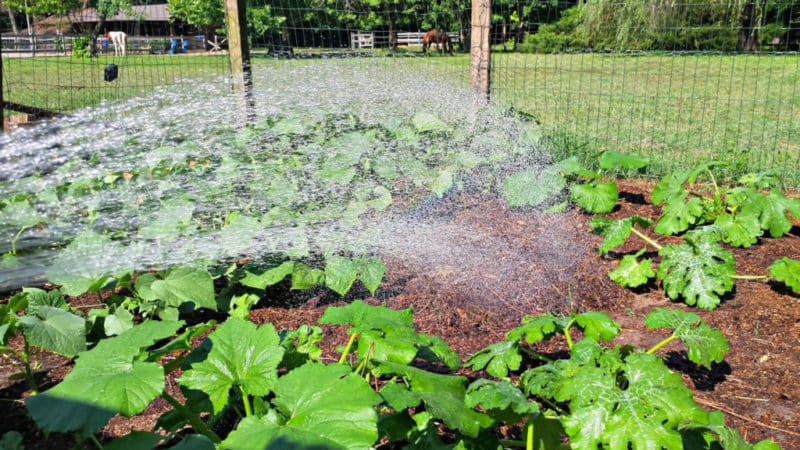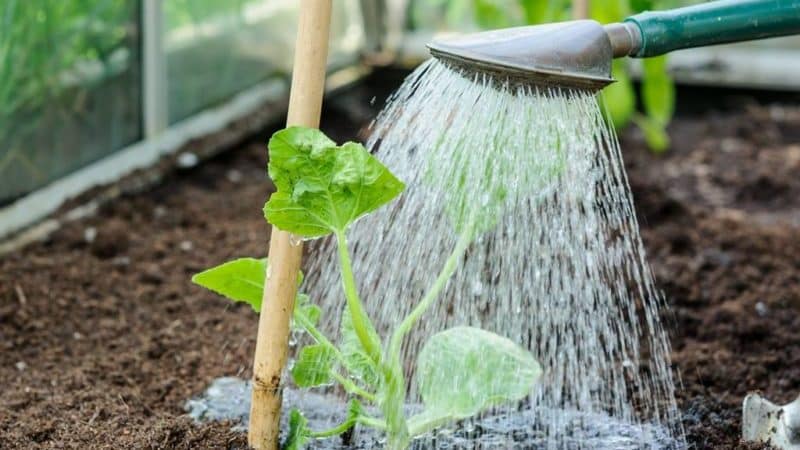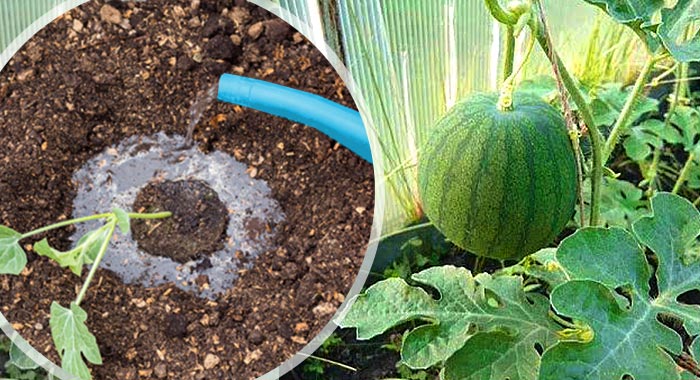How often to water watermelons and melons in a greenhouse and open ground
Even a novice gardener can grow a watermelon or melon in a summer cottage. Although these plants are adapted to the southern regions, in central Russia they also harvest a decent harvest by growing watermelons and melons in greenhouses.
Melon crops are unpretentious in care, but there are peculiarities of their irrigation. Let's consider how often and correctly to water watermelons and melons.
How to tell if melons and watermelons need watering

In each growing season there are several signs by which it is determined that plants need water:
- seeds germinate poorly;
- seedlings develop slowly;
- the bush looks weak: it has thin stems and a weak root system;
- leaves and lashes dry out, wither and curl;
- a small number of ovaries are formed;
- the fruits are deformed, their sizes do not correspond to the norms.
How often to water watermelons

Watermelons need timely and proper watering throughout the entire active growing season. There are several factors that determine the intensity and frequency of irrigation. These include:
- Soil composition and structure. Sandy loam, sandy and medium-heavy soil, due to its looseness, does not retain moisture for a long time, so more frequent moistening will be required. Clay soil retains moisture for a long time in the upper layers, so 1-2 waterings per week are sufficient.
- Location of groundwater. The closer they are, the less often watering is carried out.
- Quality of agrotechnical measures. The more often you loosen and mulch the soil, the more evenly the moisture will be distributed and the less often irrigation will be required.
- Phase of growth and development of melons. During different periods of the growing season, the frequency and intensity of irrigation changes.
To irrigate these crops, only warm water is used. The optimal temperature for watermelons is +20...+22°C, for melons - +22...+25°C. If the water is cold, the root system will begin to rot.
It is recommended to water the planted watermelon seeds daily, then less often - 3 times a week. After planting in the ground, watermelons need 2-3 moistenings per week, carried out at the root. When the fruits begin to set and ripen, irrigation is made even more rare, but plentiful - 10–12 liters of water. By the time of harvest, watering is practically stopped, preventing the soil from completely drying out.
How often to water melons
Watering melons is a little different than watering watermelons. Seedlings need daily moisture. After planting in the ground, irrigation is carried out as needed. Water is poured into each hole, keeping the soil moist.
Before the flowers appear, 2-3 liters of water are poured under each bush, in the flowering phase - 5-7 liters. When fruits begin to set, reduce irrigation to 1-2 times a week. Water in a volume of 10–12 liters is poured into the grooves created between the plants. Shortly before harvesting, melons are not watered.
Frequency and rules for watering watermelons and melons in a greenhouse
In most regions of Russia, climatic conditions are not very suitable for growing watermelons and melons in open ground, so many summer residents plant melons in greenhouses.
Reference. Since watermelons and melons need space, the greenhouse itself should be at least 2 m in height. The holes are located at a distance of 1 m from each other.
Despite their good drought tolerance, these crops require abundant watering. To get a good harvest, it is important to adhere to the following irrigation rules:
- In the first days after planting, seedlings are watered every other day. In the first 5 days of flowering, irrigation is stopped to form female flowers; during the period of fruit ripening, they are watered as needed (up to 1-2 times a week), but abundantly. By the time of harvest, watering practically stops.
- When watering, water should not fall on the core and leaves.
- The humidity in the greenhouse should not exceed 50%, so the room is often ventilated.
- The soil should be moistened to 70 cm deep.
After watering, the plants are fertilized with mineral fertilizers and the soil is loosened so that the root system receives nutrients and moisture.
In the open ground
In general, the frequency and rules of irrigation are similar to those in greenhouses. There is one main difference: watering depends on weather conditions. If the weather is cloudy and it rains, there is no need to additionally moisten the soil. Irrigate melons with warm water in the morning or evening.
Frequency of watering watermelons and melons at the seedling stage
The taste of the future harvest depends on proper moisture in each phase of plant development.
Transplant field

Planted seedlings need moist soil, so irrigation is carried out every 2-3 days, spending up to 3-5 liters of water per plant. If the soil is moist at the time of the next watering, reduce the frequency.
In the flowering stage
In the first days of flower formation, it is recommended to avoid watering. Then it is enough to irrigate the melons 1-2 times a week, pouring up to 7 liters of water under one plant.
Attention! Gardeners often make the mistake during this period of watering watermelons and melons excessively. This leads to the formation of empty flowers and the falling of flowers.
In the fruiting stage
When the ovaries are formed and the fruits begin to grow and develop, it is enough to irrigate the crops once a week, pouring at least 10 liters per plant. It is very important to prevent water from getting on parts of the bush, especially the fruits, so that rot does not develop.
Watering frequency in hot and rainy weather

In hot weather, watermelons and melons need more frequent hydration, so irrigation is carried out 2 times a day: early in the morning and in the evening. It is recommended that greenhouse plants have proper ventilation to prevent them from becoming too humid and causing fungal diseases to develop.
In cloudy and rainy weather, the frequency of irrigation is reduced or stopped altogether. After rain and thunderstorms, melons are watered a week later.
Watering frequency for drip irrigation

Recently, instead of manual watering (with a watering can or bucket under a bush) and from a hose, summer residents have been using the drip method of irrigating melons and melons. Its advantages:
- saves effort, time and water consumption;
- the soil does not erode under the bush;
- water does not get on parts of the plant;
- Fertilizers are applied simultaneously with watering.
Such systems are bought in a store or built independently, connecting hoses to each bush. Irrigation is carried out as needed. Experienced gardeners turn on the system daily, in the morning or evening, for about an hour. This gives each plant up to 1-2 liters of water.
Read also:
How to make delicious and simple jam from watermelon rinds.
The most delicious recipes for pickling whole watermelons in a barrel for the winter.
Features of growing watermelons in Siberia in open ground: step-by-step instructions.
Conclusion
The productivity of watermelons and melons largely depends on proper irrigation.In accordance with the vegetative phase, the frequency and intensity of watering is determined: young seedlings are moistened every 2-3 days, and during fruit development, irrigation is minimized, but water consumption is increased.
When watering, it is important to consider where the plant is planted (in a greenhouse or open ground) and what the weather and climatic conditions are in the region.